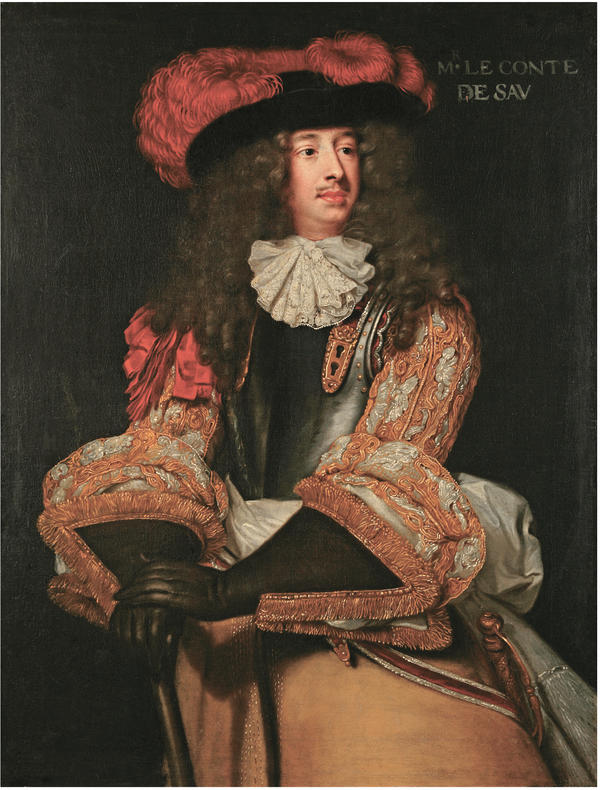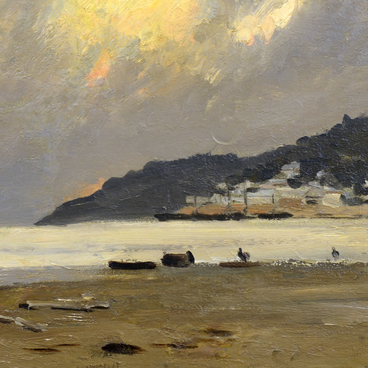For a long time, the exhibited portrait was anonymous, up to the moment when collector of ancient fine arts Sergey Zhelinsky, in his letter to Serpukhov Museum of History and Art of 21 January 2017, suggested to attribute the authorship to Henri Gascar.
This attribution was based on the portrait of French Lieutenant General Jacques III de Goyon, Lord of Torigny, Count of Matignon painted by Gascar around 1660. That portrait is quite close to the exhibited one in terms of painting style and format, while it is almost identical as to composition and the costume. It is highly likely that both canvases belong to a single series picturing the warlords of Louis XIV.
Henri Gascar is a French portrait painter. He achieved success in England during the reign of Charles II. He is believed to have come to England on invitation from Louise Renée de Kérouaille, a mistress of the King.
Gascar’s colorful and emotional style, contrasting with his rigorous approach, soon made him popular with court ladies and aristocracy. In 1860, the artist returned to Paris and was elected a member of the Royal Academy of Painting and Sculpture. He spent the rest of his life in Rome.
The painting depicts Eugène Maurice de Savoie-Carignan, Count of Soissons since 1656. This is confirmed by his portrait painted by Pierre Mignard around 1700 that is kept in the Stockholm National Museum.
Eugène Maurice was a descendant of the younger branch of the Princes of Savoy. In 1657, he married Olympe Mancini, a niece of the French Prime Minister Cardinal Jules Mazarin. Due to the good marriage, he received a high military position and became the Governor of the province of Champagne. He took part in the defeat of the Spanish Army at Dunes in 1658, was the Ambassador Extraordinary of France at the Coronation of Charles II. In 1672, for merits in the war of England and France with Spain of 1655-1659 and the War of Devolution of 1667-1668, Eugène Maurice was bestowed the rank of Lieutenant General. He died of deadly fever in the city of Unna in Westphalia in 1673. It is very likely that the Count was poisoned.
The portrait is distinguished by the life-like charm and complexity of the image, where valor of the warrior is intrinsically integrated with refinement of the courtier. Eugène Maurice de Savoie-Carignan is clad in a sleeveless justaucorps frock of yellow swede. White and gold shirt sleeves can be seen from underneath the cuirass. There is a red bow on his right shoulder; he is wearing a round black hat with a red aigrette and gloves with cuffs embroidered with golden fringes. Most likely, this is an earlier version of French uniform for top-ranking military.
This attribution was based on the portrait of French Lieutenant General Jacques III de Goyon, Lord of Torigny, Count of Matignon painted by Gascar around 1660. That portrait is quite close to the exhibited one in terms of painting style and format, while it is almost identical as to composition and the costume. It is highly likely that both canvases belong to a single series picturing the warlords of Louis XIV.
Henri Gascar is a French portrait painter. He achieved success in England during the reign of Charles II. He is believed to have come to England on invitation from Louise Renée de Kérouaille, a mistress of the King.
Gascar’s colorful and emotional style, contrasting with his rigorous approach, soon made him popular with court ladies and aristocracy. In 1860, the artist returned to Paris and was elected a member of the Royal Academy of Painting and Sculpture. He spent the rest of his life in Rome.
The painting depicts Eugène Maurice de Savoie-Carignan, Count of Soissons since 1656. This is confirmed by his portrait painted by Pierre Mignard around 1700 that is kept in the Stockholm National Museum.
Eugène Maurice was a descendant of the younger branch of the Princes of Savoy. In 1657, he married Olympe Mancini, a niece of the French Prime Minister Cardinal Jules Mazarin. Due to the good marriage, he received a high military position and became the Governor of the province of Champagne. He took part in the defeat of the Spanish Army at Dunes in 1658, was the Ambassador Extraordinary of France at the Coronation of Charles II. In 1672, for merits in the war of England and France with Spain of 1655-1659 and the War of Devolution of 1667-1668, Eugène Maurice was bestowed the rank of Lieutenant General. He died of deadly fever in the city of Unna in Westphalia in 1673. It is very likely that the Count was poisoned.
The portrait is distinguished by the life-like charm and complexity of the image, where valor of the warrior is intrinsically integrated with refinement of the courtier. Eugène Maurice de Savoie-Carignan is clad in a sleeveless justaucorps frock of yellow swede. White and gold shirt sleeves can be seen from underneath the cuirass. There is a red bow on his right shoulder; he is wearing a round black hat with a red aigrette and gloves with cuffs embroidered with golden fringes. Most likely, this is an earlier version of French uniform for top-ranking military.



